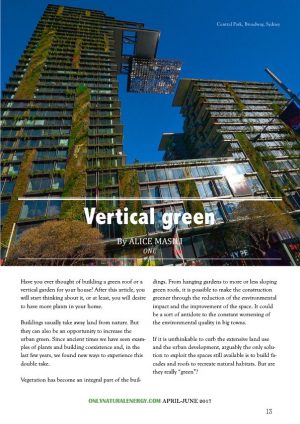 Have you ever thought of building a green roof or a vertical garden for your house? After this article, you will start thinking about it, or at least, you will desire to have more plants in your home.
Have you ever thought of building a green roof or a vertical garden for your house? After this article, you will start thinking about it, or at least, you will desire to have more plants in your home.
Buildings usually take away land from nature. But they can also be an opportunity to increase the urban green. Since ancient times we have seen examples of plants and building coexistence and, in the last few years, we found new ways to experience this double take.
Vegetation has become an integral part of the buildings. From hanging gardens to more or less sloping green roofs, it is possible to make the construction greener through the reduction of the environmental impact and the improvement of the space. It could be a sort of antidote to the constant worsening of the environmental quality in big towns.
If it is unthinkable to curb the extensive land use and the urban development, arguably the only solution to exploit the spaces still available is to build facades and roofs to recreate natural habitats. But are they really “green”?
The advantages of vertical gardens and green roofs may go well beyond the decorative aspect. Both allow achieving excellent levels of thermal insulation during winter and summer, reducing the use of air conditioning in summer and providing a suitable protection during winter. They also bring a significant reduction of conditioning and heating costs and an energy saving.
Besides, plants protect exterior walls and roofs from exposure to UV rays, rain and, temperature variations, making them three times more durable. This is a huge saving in economic terms.
The installation of a green roof and or a vertical garden can reduce by 23% the energy consumption for heating and by 75% the energy consumption for air conditioning. Plants can fend off most of the heat and contribute to the lowering of the temperature.
The plants also release moisture, thus cooling the air. They contribute to a decrease in the levels of CO2 in the air and the reduction of global warming, as well as help to capture fine particles that pollute cities, improving air quality.
Plants absorb the most persistent and insidious pollutant, such as formaldehyde, often nested in resins of wood or household disinfectants, providing a significant contribution to the health of its inhabitants. The presence of green promotes recovery from stress, and all the inhabitants of the building can enjoy such beneficial effect.
The right combination of soil, plants, and air contribute to achieving an optimum level of insulation, a barrier against the typical noise of cities. In fact, they can capture and reflect the sound waves. The substrate lock lower sound waves, while plants retain the higher frequencies.
Green roof and vertical garden ideas come from the increasing need to create spaces of vegetation in cities. The most obvious advantage is to regain space where it looks impossible. With no usable land left by the buildings, there is an incredible variety of plants, which can well expand skyward.
The beauty of a flower garden is undeniable. Green roofs and vertical gardens are not just aesthetically nice items; they are good for health, by reducing the carbon dioxide from the air, and positively influence mood and stimulate the sense of wellbeing and relaxation.
It’s not only about beauty; it’s more about being practical: it is possible to install greenhouses and small urban gardens, to let them grow with buildings.
Vertical green can be an attractive solution to (re)cover abandoned buildings or peripheral buildings. Furthermore, they improve the aesthetic and visual impact of the house with a consequent rise in its real estate value.
Unfortunately, all that glitters is not gold. First, it is important to know if our building, or roof, could support the weight of layers and plants chosen to create our beautiful lush garden. In fact, a green cover could weight from 20 to 2000 kg per sq. Furthermore, flowers, small shrubs, and plants, in general, require high-maintenance and subsequent artificial irrigation to maintenance.
In addition to the manufacturing costs, you have to consider the additional ones for its support and care. To pick succulent plants, which require less care and maintenance, could be an easy way to have evergreen and lush palaces. The importance of the waterproof system should not be underestimated. At the base of an actual realization, there is the waterproof layer, which must guarantee maximum hold, functionality, and durability; otherwise, all efforts will be frustrated by problems of infiltration.
Although expensive, to add green to any city centre should be a standard target. More: a tool to improve our wellness and an enjoyable way to create opportunities of sociability, to build partnerships and to educate.
Alice Masili


